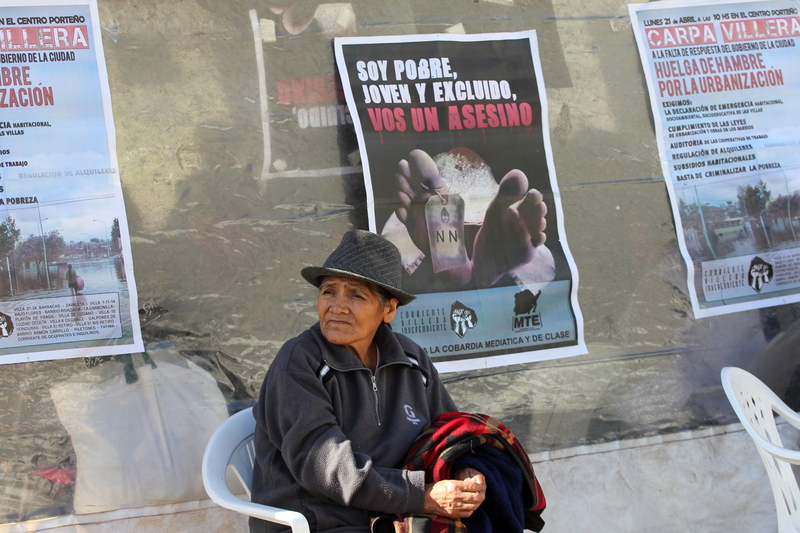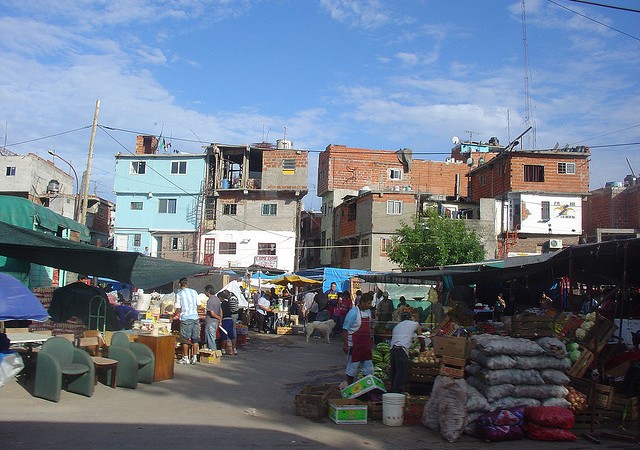
Residents of slums set up a protest tent near Obelisk, 22 April 2014 by Claudio Santisteban, Demotix.
All links without [es] are in English.
Argentina's shantytowns—the villas miserias—are in an identity crisis. Shantytown identity is a culture all its own, but it doesn't enjoy the visibility many other cultures do. Greater recognition would allow these disadvantaged communities to stop living in the shadows and grab hold of some genuine pride. Besides being about socioeconomic status, “slum identity” also has its own unique music, language, and comedy.
Argentina's shantytowns could soon be getting some help to establish their identity, now that the government has preliminarily approved a plan to make October 7 “Slum Identity Day” [es] [Día de la Identitidad Villera]. The date was chosen to honor ‘slum’ priest, Father Carlos Mugica [es].
The product of Argentina's socioeconomic issues, slum identity also has a strong presence in local music, where it's known as cumbia villera [shantytown cumbia], name given by its creator, Pablo Lescano [es], whose blog traces the genre's roots. His music group, Damas Gratis, celebrates this history [es].
Corría el año 1999 y Pablo tiene un accidente en moto por lo que es operado de las 2 piernas y queda postrado en camilla. Es ahi donde empiesa (sic) a formarse la idea de tener un grupo que toque colombianos y haga mover a la gente en el baile. Estando en camilla crea las letras del primer disco de Damas Gratis “Para Los Pibes” , claro que faltaba un cantante. Al ver que no se conseguia cantante para el nuevo proyecto decide darle èl (sic) la voz a la banda. Es asi que nace “Damas Gratis”.
In 1999, Pablo was involved in a motorcycle accident that left him disabled and bedridden. During this time, he began to think of putting together a group that played Colombian music and made people dance. While bedridden, he wrote the words for the Damas Gratis's first album, Para Los Pibes [For the Boys]. He was still missing was a singer, however. Unable to find one, he became the lead vocalist. That's how Damas Gratis was born.
Argentinan slum identity also has its own dialect, better known as Lunfardo Villero [es].
Voy a contarles un poco sobre la jerga villera, el lenguaje con el que se identifican quienes habitan las villas miseria y en el que cristaliza la realidad social, cultural y económica de una clase que suele ser estigmatizada por la pobreza, la delincuencia y las drogas. La música, especialmente la ‘cumbia villera’, es esgrimida como marca identitaria y expresión de esa realidad.
I'm going to talk a little about slum jargon. It is the language that identifies its inhabitants and crystalizes the social, cultural, and economic reality of a people often stigmatized due to poverty, crime, and drugs. Music, especially “cumbia villera,” is considered an important way to express this identity.
Here are some slum terms found on the blog, Español (con Virgulilla) [es] [Spanish (with a Tilde)]:
mechero: persona que roba ropa en las tiendas(del Pequeño Diccionario tumbero)
chamullar: charlar, conversar, generalmente con el fin de lograr algo. Chamullo/Chamuyo es una palabra que el lunfardo tomó del caló (dialecto de los gitanos de España). En “La reina del tango”, Enrique Cadícamo escribió: El gotán se te fue al corazón como un dulce chamullo de amor.
tranza: vendedor de droga
chorro: ladrón
gil (palabra del lunfardo que también deriva del caló): tonto. En su Diccionario del lunfardo, Gobello menciona los aumentativos gilón y gilún, este último con influencia del genovés, así como los despectivos gilastro y gilastrún. También es usual la inversión “logi”
fierro: revólver
mechero: one who steals clothes from a store (from the Pequeño Diccionario tumbero [es] – The Small Dictionary of Prision-isms).
chamullar: to chat or converse with the purpose of accomplishing something. Chamullo/chamuyo is a Lunfardo word taken from the Spanish Gypsy dialect, Caló. In “The Queen of Tango,” Enrique Cadícamo wrote, “Tango struck your heart, just like sweet nothings.”
tranza: one who sells drugs
chorro: theif
gil: (another Lunfardo word deriving from Caló): dumb. In the Lunfardo Dictionary, Gobello mentions aumentatives, gilón and gilún. The latter has been influenced by Genoese, along with the derogatory terms gilastro and gilastrún. Written backwards, logi, is also common.
fierro: revolver
A year ago, Argentina witnessed the first Slum Stand-up [es]—a type of street comedy or monologue about life in the shantytowns. YouTube user Cosecha Roja [es] shared a video about this genre of stand-up:
While the government has approved the plan to celebrate Slum Identity Day, the country's political opposition questions the wisdom of “paying homage to poverty.” The blog, El no soy lo que debería [es] [I'm not who I should be] asks if celebrating the shantytown's “way of life” is rational:
Lo que tiene que hacer el Estado es tener el Norte de que no haya mas (sic) villas. No reivindicar el orgullo villero. Nadie que elija quiere vivir en un lugar con olor a mierda, durmiendo tres generaciones en una pieza, y teniendo escuelas de cuarta y pasando miseria. Nadie quiere elegir la villa.
What the government needs to do is make sure there are no more shantytowns in the North, not uphold slum pride. Nobody chooses to live in a place that smells like shit, where a three-generation family sleeps in one room, where the schools are poor-quality, and everyone lives miserably. Nobody chooses the slum.

Slum 31 Refuge Buenos Aires from flickr user Ever Daniel Barreto Rojas released under (CC BY-NC-SA 2.0)
Panamá Revista [es] [Panama Magazine] analyzed the work of slum priests, which defends their work and why poverty is wrong [es].
Volvamos a decirlo con libertad: la pobreza está mal. Nuestro Estado laico y moderno no puede pensar como los curas villeros, aunque todos valoremos en ellos una expresión cristiana mucho más notable que el puro moralismo de Héctor Aguer. Estos curas hablan de “integración urbana”. Hablan “desde adentro”, porque viven en las parroquias dentro de las villas, y articulan un discurso místico y político contra las intromisiones del Estado y la política. Es posible pensar que en nombre de esa reivindicación que subraya tanto el adentro y el afuera se acentúa un obstáculo para contar con una visión integradora: el reconocimiento prioritario de los derechos que faltan. No sea cosa que la reivindicación cultural de la villa asumida como insolencia contra las culturas elitistas que la estigmatizan, encubra una política conservadora.
Let’s say it again openly: poverty is wrong. Our secular and modern government cannot think as the ‘slum’ priests do, even if we value them as being more Christian than Héctor Aguer’s moralism. These priests talk of “urban integration.” They speak “from within,” because it is they who live within the village parishes, giving mystical and political sermons against state and political interference. One may think that on behalf of this demand, which affects both in and outside the slums, the obstacle hindering integration is magnified—acknowledging a lack of rights. Let’s not have the cultural vindication of the slums be understood as insolent behavior against the cultural elitists who stigmatize it, and allow this to conceal what is ultimately a conservative policy.






